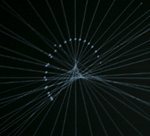
X-MOTION
X-MOTION
description documentation
CHOREOGRAPHISMS
UNSQUARE DANCE
RELATED WORK
PUBLICATIONS
PEOPLE
The system captures the position from the markers the dancers are wearing using an camera sensitive to infrared light (IR). It then extract parameters from the video images; position, speed, curvature, etc. of the paths captured for each marker. Then it binds a Finite State Machine (FSM) to each marker. Each state of the FSM is characterized by a graphical behavior that will determine how the drawing parameters are affected for the captured curve parameters. The states transitions (which determines the drawing behaviors) will be fired out by conditions in the curve parameters (i.e. for example: Speed x > 0.7 pixels/frame). The performer can design the FSMs for the markers, as well as control the drawing state while performing.
Architecture

These are the objects and data structures that build our system architecture:
Cameras and input devices:
The input from different input devices is captured.
Sensing module:
Gets input devices data and analyzes acording with the directions of the
motion engine to modify some global state parameters.
User Interface:
Is the entitie that let us define the initial parameters used to initialize the
programing module and FSMs.
Programming module:
Takes controll of the program flow.
Motion Engine:
Takes information from the global state parameters and drives the output
graphics to be projected.
Global state:
A set of classes that stores information of the parameters calculated at each
program update. When the FSMs are updated with these parameters, some
state transition can be produced. The FSMs are part of the global state too.
Graphics interpretator module:
When is updated, gets information from the global state parameters and
translates into a rendered video output.
Projectors:
Show the rendered images on a screen.